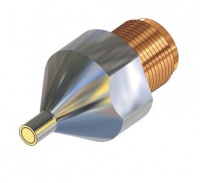Researchers at Birmingham University have developed a process to build ultrasound transducers that operate at more than three times the frequency of conventional devices. They believe the process could enable the development of a new breed of medical imaging devices where high resolution and low surface penetration are demanded.
Ultrasound-based diagnostic imaging systems have been used to create images of subcutaneous body structures. Such systems which work at frequencies above the audible range of human hearing employ piezoelectric transducers that are placed on the surface of a body to be imaged. When excited by an electrical stimulus, these transducers create an ultrasound signal that penetrates the body. Reflected signals from features in the body are then detected by the same transducer and converted back into electrical signals that are processed to obtain an image.

Button said: ’The process creates a dense material almost identical to that produced by conventional processes, with the exception that the fine-scale structure of ceramic material is already encapsulated within it, obviating the need to perform machining processes to produce the pillars of ceramic material.’
The process can also produce pillars of ceramic material that are random in their lateral dimensions. That means that the transducer created using Button’s method produces a composite structure where any unwanted resonances are eliminated.
Button said applications for the high-frequency transducers manufactured using the VPP technique would be in systems that could produce images of surface or near surfaces, where high-resolution imaging is required, yet where the depth of penetration of the acoustic signal is not as important as in more conventional image-processing systems.











Construction industry lags in tech adoption
Are these the best people to ask "Insights from 2,000 Industry Leaders"? - what would their customers views be like (perhaps more...